Introduction
The package mdepriv translates the homonymous Stata command (Pi Alperin & Van Kerm, 2009) for R users.
mdepriv offers four methods to calculate synthetic scores of multiple deprivation from unidimensional indicators and/or basic items of deprivation. While it originated in the field of poverty research, it is equally suitable for measures of the severity of humanitarian conditions.
The methods offer a range from simple aggregation of equally weighted indicators to more involved ones that take into account desired traits of deprivation and severity indices. The user has the option to 1. penalize redundant items / indicators with lower weights and/or 2. to reward better discriminating ones with higher weights - or neither. All methods generate unit-level deprivation / severity scores that are linear combinations of the items / indicators, with their weights designed to sum to one. They return user-defined selections of output elements, with the aggregate deprivation level and a table of item / indicator means, weights and contributions to the aggregate deprivation / severity as the default.
mdepriv accepts indicators and items standardized to the interval [0,1]. It does not accept arguments with missing values; such observations have to be removed from the dataframe or matrix input beforehand. All items / indicators have to be oriented negatively (higher values denote less desirable states).
Fundamentally, the four methods
- Equi-proportionate
- Desai & Shah (1988)
- Cerioli & Zani (1990)
- Betti & Verma (1998)
differ by their increasing sensitivity to deprivations / adverse conditions suffered by the poorest / most oppressed units (individuals, households, communities). The idea is to weight more strongly specific deprivations / adverse conditions that the more advantaged units have overcome, but which are still afflicting those at the bottom. Typically, in poverty studies, this makes good sense with durable household assets, which are observed as dichotomous “has / does not have” and recorded as binary (0/1) variables.
In humanitarian assessments it is less common that the severity of a lacking / suffering / threat is inversely proportionate to its prevalence. When prevalence-dependent weighting is not appropriate, mdepriv gives the user three options:
- Equi-proportionate weighting
- Unequal weights chosen for substantive considerations
- Switching off prevalence-sensitivity
This third option is meaningful primarily in combination with the Betti-Verma method. This method deserves particular attention. Its defining feature is a double-weighting algorithm:
- The first weighting factor gauges the discriminating power of an item / indicator through its coefficient of variation (= standard deviation / mean). For dichotomous items / indicators, this implies high sensitivity to prevalence (the C.o.V. grows exponentially as the proportion tends towards zero). For continuous ones, higher C.o.V.s imply higher information content.
- The second weighting factor results from the correlations among the items / indicators. Those correlated strongly positively with most others are considered more highly redundant and are penalized with lower weights. Those with comparatively low positive or negative sums of correlation coefficients are considered capturing more unique aspects of deprivation / humanitarian conditions and are rewarded with higher weights.
Betti-Verma is the only one among the four methods sensitive to the information content of continuous items / indicators. mdepriv automatically computes the weight of each item / indicator proportionate to the product of its two weighting factors.
The mdepriv function makes
the second weighting factor available also for the other three methods,
but not all combinations are practically meaningful.
mdepriv automatically recognizes the appropriate type of
correlations between pairs of items / indicators, but the user can
impose a particular type collectively on all pairs (rarely meaningful!).
When the user opts for double-weighting (other than in Betti-Verma,
where it is the default), the options have to be specified for both
factors. mdepriv notation for the first factor is
wa, for the second it is wb. However, not all
combinations are practically meaningful. Recommended combinations depend
on the analytic objective. Plausibly, the most relevant are:
| Objective | First weighting factor (wa) | Second weighting factor (wb) |
|---|---|---|
| Indifferent to prevalence (dichotomous items) and to information content (continuous). But controlling for redundancy is important. | Equi-proportionate | on |
| Items are all dichotomous. Limited sensitivity to low prevalence desired. Not controlling for redundancy. | Desai-Shah | off |
| Items are all dichotomous. High sensitivity to low prevalence desired. Not controlling for redundancy. | Betti-Verma | off |
| All items are continuous, and controlling for redundancy is important. | Betti-Verma | on |
| Items are mixed dichotomous / continuous. Indifferent to prevalence of the dichotomous, but concerned for information content of the continuous. Redundancy control is important. i.e. Two-level deprivation / severity model: | ||
| Level 1: Combine all dichotomous items, save scores as one more continuous indicator for the second level. | Equi-proportionate | on |
| Level 2: Combine continuous items and indicator saved from first level. Produces aggregate deprivation / severity statistic. | Betti-Verma | on |
The Cerioli-Zani model appears to be primarily of historic interest. It was one of the first to pursue the so-called fuzzy-set approach to multi-dimensional poverty measurement, which Betti and Verma subsequently deepened. The interested user may consult the reader edited by Lemmi and Betti (2006), but familiarity with fuzzy sets is not required for the understanding and application of mdepriv.
As a final introductory remark, it should be said that the Betti-Verma method is particularly appropriate when a concept (deprivation, severity of conditions, etc.) has many aspects, its dimensionality is not well understood, and classical methods to unravel the dimensions (e.g., factor analysis) are likely distorted by redundancies among the available indicators.
The following focuses on the technical handling of the
mdepriv package. Context and rationale are not discussed
here. The purpose is to walk the user through the manifold arguments and
outputs of the core function mdepriv. Familiarity with the
basics of R is presumed. Still, things are kept at a pretty low skill
level so that users with little R experience can follow. The code
provided is intended as copy-and-paste material, which users can modify
for practice or for real-world data analysis.
Chiefly we will use the simulated dataset simul_data
with 100 observations, which are enough to demonstrate functionality. To
showcase a two-level deprivation model we
put the dataset MSNA_HC to use. Both datasets are part of
the mdepriv-package; thus they do not require further
sourcing.
Requirements
Packages used in the following:
# install package remotes if not yet installed
# install.packages("remotes")
# install fast from GitHub without vignettes (not recommended)
# remotes::install_github("a-benini/mdepriv")
# recommended: installation from GitHub including vignettes:
# remotes::install_github(
# "a-benini/mdepriv",
# build_vignettes = TRUE,
# dependencies = c("Imports", "Suggests")
# )
library(mdepriv)
help(package = "mdepriv") # mdepriv package documentation
# install.packages("tidyverse")
library(tidyverse) # includes packages for data handling and graphics
# install.packages("visdat")
library(visdat) # package for preliminary visualization of dataA Minimalist Start
When using the function mdepriv to calculate synthetic
scores of multiple deprivations, at a minimum the first two of its
arguments - data and items - need to be
specified. The former is a data.frame or
matrix containing the items as columns. The later contains
the column headings of the items of interest as character strings.
mdepriv(data = simul_data, items = c("y1", "y3", "y4", "y7"))
#> $weighting_scheme
#> [1] "Cerioli & Zani (1990) weighting scheme"
#>
#> $aggregate_deprivation_level
#> [1] 0.299315
#>
#> $summary_by_item
#> Item Index Weight Contri Share
#> 1 y1 0.16000 0.4118528 0.06589645 0.2201575
#> 2 y3 0.53000 0.1426820 0.07562147 0.2526484
#> 3 y4 0.27600 0.2893190 0.07985203 0.2667826
#> 4 y7 0.49918 0.1561462 0.07794506 0.2604115
#> 5 Total NA 1.0000000 0.29931501 1.0000000
#>
#> $summary_scores
#> N_Obs. Mean Std._Dev. Min Max
#> 1 100 0.299315 0.2437652 0 1The above call generates four default output elements. The effective weighting scheme is flagged. The aggregate deprivation level is printed out to several digits; for comparisons two informative ones are usually enough. The summary by item is the key output. The index is the proportion of a binary item or the mean of a continuous one. The weights sum to one. The item-wise contributions are the products of the respective indices and weights. Their sum is the aggregate deprivation / severity level. The shares are the relative contributions, such that they sum to one. The summary scores returns minimal descriptive statistics of the scores, which are the unit-level synthetic deprivation values. The mean score, by design, is identical with the total of contributions and the aggregate deprivation level.
As long as the arguments are specified in the correct order, it’s not necessary to write them out:
What mdepriv Can Return
mdepriv‘s returns can be selected by the multiple choice
argument output. The output options
"view" and "all" are wrappers for
output-compilations (s. below),
the former being output’s default setting. If
output consists of a single element, a single object is
returned as such. Multiple returns are gathered in a named
list. For more detailed information on the returns have a
look at the section ’Value’ on mepriv’s help page.
help("mdepriv")| possible output element | included in view | included in all | class / object type | useable as argument in other models |
|---|---|---|---|---|
| weighting_scheme | X | X | single character string | |
| aggregate_deprivation_level | X | X | single numeric value | |
| summary_by_dimension | X(*) | X(*) | data.frame | |
| summary_by_item | X | X | data.frame | |
| summary_scores | X | X | data.frame | |
| score_i | X | numeric vector | ||
| sum_sampling_weights | X | single numeric value | ||
| data | X | data.frame | X | |
| items | X | list | X | |
| sampling_weights | X | single character string | X | |
| wa | X | single character string | X | |
| wb | X | single character string | X | |
| rhoH | X | single numeric value | X | |
| user_def_weights | X | list or single NA-value | X | |
| score_i_heading | X | single character string | X |
The output elements re-usable as arguments in subsequent models (s.
above) retain the model settings effectively
used, either by default or user-specified. How these settings are passed
on to other models is shown by the examples of
items and of
data. The output elements
"weighting_scheme", "wa", "wb",
"rhoH" and "user_def_weights" can be used to
check the specifics of the applied
weighting scheme. Rationale and the how-to of recycling
"wa", "wb", "rhoH" or
"user_def_weights" are given here.
X(*): Unless two or more dimensions have been specified,
the data.frame summary_by_dimension is dropped
from the output-compilations "view" and
"all". In these cases also the column
Dimension is dropped from the data.frame
summary_by_item. This makes the output more compact.
However, when processing returns of several mdepriv-models,
some with, others without dimension-specification, a homogenous output
structure may be advantageous (s.
below). The summary_by_dimension-table, respectively
the column Dimension in the
summary_by_item-table can be enforced by explicitly
specifying "summary_by_dimension" as an
output-element:
mdepriv(simul_data, c("y1", "y2", "y3"), output = c("view", "summary_by_dimension"))
#> $weighting_scheme
#> [1] "Cerioli & Zani (1990) weighting scheme"
#>
#> $aggregate_deprivation_level
#> [1] 0.3113771
#>
#> $summary_by_dimension
#> Dimension N_Item Index Weight Contri Share
#> 1 Dimension 1 3 0.3113771 1 0.3113771 1
#> 2 Total 3 NA 1 0.3113771 1
#>
#> $summary_by_item
#> Dimension Item Index Weight Contri Share
#> 1 Dimension 1 y1 0.16 0.6489002 0.10382403 0.3334350
#> 2 Dimension 1 y2 0.70 0.1262953 0.08840671 0.2839217
#> 3 Dimension 1 y3 0.53 0.2248045 0.11914640 0.3826434
#> 4 Total <NA> NA 1.0000000 0.31137714 1.0000000
#>
#> $summary_scores
#> N_Obs. Mean Std._Dev. Min Max
#> 1 100 0.3113771 0.2907748 0 1For a simple overview or for further processing with a narrow
objective, specifying one or at most very few output-elements should
suffice. When doing elaborated analysis it is most likely convenient to
specify the output as "all" and to save the
mdepriv-return which in this case is a list.
Next the user can pick specific elements from the list in
several ways:
mdepriv_returns <- mdepriv(simul_data, c("y1", "y2", "y3", "y4", "y5", "y6", "y7"), output = "all")
# 3 ways to pick an element as such from list
mdepriv_returns$weighting_scheme
#> [1] "Cerioli & Zani (1990) weighting scheme"
mdepriv_returns[["weighting_scheme"]]
#> [1] "Cerioli & Zani (1990) weighting scheme"
mdepriv_returns[[1]] # by index; also works with unnamed lists
#> [1] "Cerioli & Zani (1990) weighting scheme"Warning: Don’t confuse a list of only 1 element with the
very element as such:
mdepriv_returns["aggregate_deprivation_level"] # a list with only 1 element ...
#> $aggregate_deprivation_level
#> [1] 0.3719576
mdepriv_returns[["aggregate_deprivation_level"]] # ... and the very element as such ...
#> [1] 0.3719576
# ... might look somewhat the same
mdepriv_returns["aggregate_deprivation_level"] == mdepriv_returns[["aggregate_deprivation_level"]]
#> aggregate_deprivation_level
#> TRUE
# but ... they are not
round(mdepriv_returns["aggregate_deprivation_level"], 2)
#> Error in round(mdepriv_returns["aggregate_deprivation_level"], 2): non-numeric argument to mathematical function
round(mdepriv_returns[["aggregate_deprivation_level"]], 2)
#> [1] 0.37
# if unsure about what you are dealing with: check!
class(mdepriv_returns["aggregate_deprivation_level"])
#> [1] "list"
class(mdepriv_returns[["aggregate_deprivation_level"]])
#> [1] "numeric"Working with the returns from multiple mdepriv models
saved as a separate lists can become cumbersome. However,
there is a convenient alternative. One can combine the returned
lists in a data.frame where every model is a
row and the different output elements are gathered as
columns/variables (s. Multiple Models in a
data.frame).
Grouping Items as Dimensions
The user may group items in separate dimensions. Each dimension is
allocated a weight sum of \(\frac{1}{K}\), K being the number of
dimensions in the model. The item weights are calculated separately for
each dimension; they too sum to \(\frac{1}{K}\) for each dimension, thus
keeping the sum total of weights = 1. The sum of item contributions
(Contri) per dimension is reflected as dimension-wise
contribution in the summary_by_dimension. The dimension
indices are “backward-engineered”, i.e. = \(\frac{contribution}{weight}\). The
deprivation scores, however, are computed in a unified way for the
entire model, not for every dimension. If the user requires
dimension-wise scores, then these must come from separate models.
Grouping items / indicators by dimensions is appropriate when there are substantive or policy reasons to keep their weights independent and their weight sums identical across dimensions. This is the case when redundancy should be controlled for among items within each group, but not between items of different groups. There may be institutional considerations, e.g., when some items may be highly correlated between groups, but the importance (weight sum) of the groups should be kept equal. For example, water deprivation and sanitation deprivation are correlated, but the humanitarian sub-sectors looking into them may need to participate in the severity calculation with equal weight.
Items are grouped in dimensions by placing them in vectors that are
elements of a list:
mdepriv(simul_data, list(c("y1", "y2", "y4"), c("y5", "y6")))
#> $weighting_scheme
#> [1] "Cerioli & Zani (1990) weighting scheme"
#>
#> $aggregate_deprivation_level
#> [1] 0.4128214
#>
#> $summary_by_dimension
#> Dimension N_Item Index Weight Contri Share
#> 1 Dimension 1 3 0.2583537 0.5 0.1291769 0.3129122
#> 2 Dimension 2 2 0.5672892 0.5 0.2836446 0.6870878
#> 3 Total 5 NA 1.0 0.4128214 1.0000000
#>
#> $summary_by_item
#> Dimension Item Index Weight Contri Share
#> 1 Dimension 1 y1 0.16000 0.26355861 0.04216938 0.10214920
#> 2 Dimension 1 y2 0.70000 0.05129636 0.03590745 0.08698058
#> 3 Dimension 1 y4 0.27600 0.18514503 0.05110003 0.12378240
#> 4 Dimension 2 y5 0.69579 0.17177312 0.11951802 0.28951505
#> 5 Dimension 2 y6 0.50004 0.32822688 0.16412657 0.39757278
#> 6 Total <NA> NA 1.00000000 0.41282144 1.00000000
#>
#> $summary_scores
#> N_Obs. Mean Std._Dev. Min Max
#> 1 100 0.4128214 0.190703 0.1204958 0.9402168If not happy with the default labelling of dimensions, the user can customize it:
mdepriv(simul_data, list('Group A' = c("y1", "y2", "y4"), 'Group B' = c("y5", "y6")),
output = c("summary_by_dimension", "summary_by_item"))
#> $summary_by_dimension
#> Dimension N_Item Index Weight Contri Share
#> 1 Group A 3 0.2583537 0.5 0.1291769 0.3129122
#> 2 Group B 2 0.5672892 0.5 0.2836446 0.6870878
#> 3 Total 5 NA 1.0 0.4128214 1.0000000
#>
#> $summary_by_item
#> Dimension Item Index Weight Contri Share
#> 1 Group A y1 0.16000 0.26355861 0.04216938 0.10214920
#> 2 Group A y2 0.70000 0.05129636 0.03590745 0.08698058
#> 3 Group A y4 0.27600 0.18514503 0.05110003 0.12378240
#> 4 Group B y5 0.69579 0.17177312 0.11951802 0.28951505
#> 5 Group B y6 0.50004 0.32822688 0.16412657 0.39757278
#> 6 Total <NA> NA 1.00000000 0.41282144 1.00000000 The set of items can be taken
from one model and passed on to another:
ds <- mdepriv(simul_data, list('Group A' = c("y1", "y2", "y4"), 'Group B' = c("y5", "y6")),
method = "ds", output = "all")
bv <- mdepriv(simul_data, ds$items, method = "bv", output = "all")
all.equal(ds$items, bv$items)
#> [1] TRUEThe output element items is always returned
as a list. This is true also when items were
passed as a simple vector of characters strings, with no dimensions
specified. The returned items remain a recyclable
argument.
class(c("y1", "y2", "y4")) # items in character vector
#> [1] "character"
model_1 <- mdepriv(simul_data, c("y1", "y2", "y4"), output = "all")
model_1$items # same items are returned in a list with one dimension
#> $`Dimension 1`
#> [1] "y1" "y2" "y4"
class(model_1$items)
#> [1] "list"
model_2 <- mdepriv(simul_data, model_1$items, output = "all")
all.equal(model_1, model_2)
#> [1] TRUE
# whether a 'one dimensional list' or a simple vector does not matter.Sampling Weights
mdepriv’s third argument sampling_weights
is optional. Its specification targets a numeric variable within the
argument data by the character string corresponding to the
very column heading. Integers as well as non-integers are admitted as
sampling weights. By default the argument sampling_weights
is set to NA, which means unspecified.
head(simul_data, 3) # see what's included in the input data
#> id y1 y2 y3 y4 y5 y6 y7 sampl_weights
#> 1 1 0 0 0 0.0 0.369 0.174 0.196 0.556
#> 2 2 1 0 1 0.2 0.762 0.832 1.000 1.500
#> 3 3 0 1 1 0.4 0.708 0.775 0.833 0.973
# if sampling_weights are specified the very specification
# and the sum of sampling weights are available as returns ...
mdepriv(simul_data, c("y1", "y2", "y3"), "sampl_weights",
output = c("sampling_weights", "sum_sampling_weights"))
#> $sum_sampling_weights
#> [1] 100.237
#>
#> $sampling_weights
#> [1] "sampl_weights"
# ... if unspecified, the outcome consequently is:
mdepriv(simul_data, c("y1", "y2", "y3"),
output = c("sampling_weights", "sum_sampling_weights"))
#> $sum_sampling_weights
#> [1] NA
#>
#> $sampling_weights
#> [1] NAStandard Methods
Four different standard methods for calculating
synthetic scores of multiple deprivations are available:
-
"cz": Cerioli & Zani (1990) weighting -
"ds": Desai & Shah (1988) weighting -
"bv": Betti & Verma (1998) weighting -
"equal": Equi-proportionate weighting
We compare aggregated deprivation levels by method and
by the use of the sampling weights or not.
items_sel <- c("y1", "y2", "y3", "y4", "y5", "y6", "y7") # a selection of items
# combinations of argument values for mdepriv()
arg_comb <- expand.grid(
method = c("cz", "ds", "bv", "equal"), # all available methods
sampling_weights = c("sampl_weights", NA), # sampling weights specified/unspecified
stringsAsFactors = FALSE
)
# aggregate deprivation levels by combination of methods and (un)specified sampling weights
aggregate_deprivation_level <- sapply(
1:nrow(arg_comb),
function(x) {
mdepriv(
simul_data,
items_sel,
method = arg_comb$method[x],
sampling_weights = arg_comb$sampling_weights[x],
output = "aggregate_deprivation_level"
)
}
)
# plot aggregate deprivation levels by argument combination
data.frame(arg_comb, aggregate_deprivation_level) %>%
mutate(
method = fct_inorder(method),
# methods as factor ordered by first appearance (-> sequence in plot)
sampling_weights = paste(sampling_weights)
# NA as string (-> avoid gray, the default color for NA)
) %>%
ggplot(aes(x = method, y = aggregate_deprivation_level, fill = sampling_weights)) +
geom_col(position = position_dodge()) +
theme_bw() +
labs(fill = "specification of\nargument\nsampling_weights") +
ggtitle("aggregate deprivation level, by method")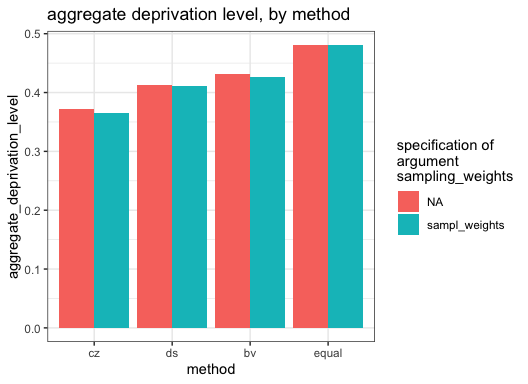
Lets investigate the differences of the methods, not
only based on the single figure
aggregate_deprivation_level, but also on a comparison of
summary_by_item-tables (Note that the above combination of method and
sampling_weights as well as the above selection of items
items_sel are being reused below.).
# list summary_by_item-tables by combination of methods and (un)specified sampling weights
summary_by_item <- lapply(
1:nrow(arg_comb),
function(x) {
mdepriv(
simul_data,
items_sel,
method = arg_comb$method[x],
sampling_weights = arg_comb$sampling_weights[x],
output = "summary_by_item"
)
}
)
# aggregate and plot listed summary_by_item-tables
tibble(arg_comb, summary_by_item) %>%
unnest(summary_by_item) %>%
filter(Item != "Total") %>%
# filter out rows with the totals inherited from the summary_by_item-tables
pivot_longer(-c(sampling_weights, method, Item), names_to = "key", values_to = "value") %>%
mutate(
key = fct_inorder(key),
method = fct_inorder(method),
# key & method as factors ordered by first appearance
# -> non-alphabetical sequences in plot grid (key as rows, method as columns)
sampling_weights = paste(sampling_weights)
# NA as string (-> avoid gray, the default color for NA)
) %>%
ggplot(aes(x = Item, y = value, fill = sampling_weights)) +
geom_col(position = position_dodge()) +
facet_grid(rows = vars(key), col = vars(method), scales = "free_y") +
theme_bw() +
labs(fill = "specification of argument\nsampling_weights") +
ggtitle("method vs. key figures from the summary by item") +
theme(legend.position = "top")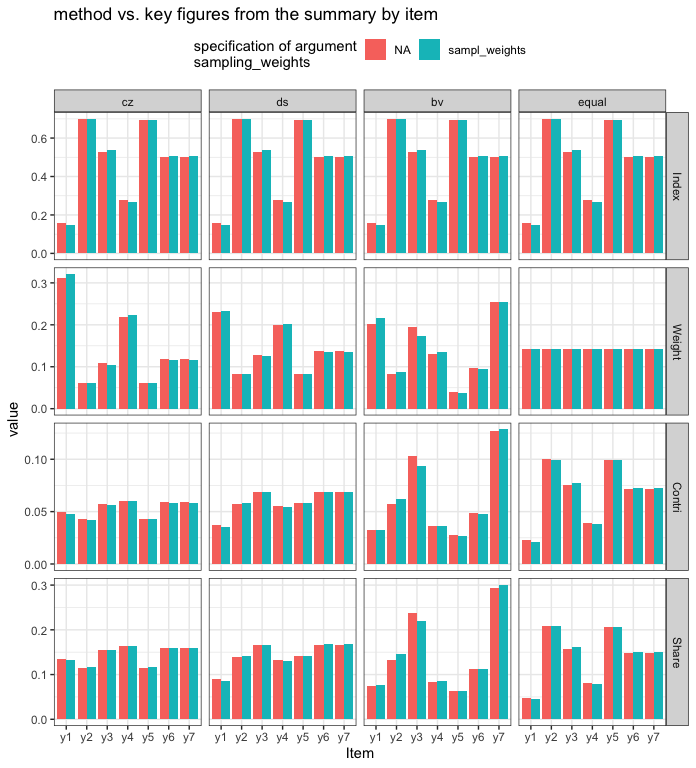
Different methods
do matter as far as their results, but this should not be confused with
the default argument settings of mdepriv:
# The Cerioli & Zani (1990) weighting scheme is the default method and must not really be specified
cz_default <- mdepriv(simul_data, c("y1", "y2", "y3"))
cz_explicit <- mdepriv(simul_data, c("y1", "y2", "y3"), method = "cz")
all.equal(cz_default, cz_explicit)
#> [1] TRUE
# The Betti & Verma (1998) weighting scheme has to be chosen explicitly, ...
bv_standard_lazy <- mdepriv(simul_data, c("y1", "y2", "y3"), method = "bv")
# ... it is associated with two further arguments with default settings.
bv_standard_explicit <- mdepriv(simul_data, c("y1", "y2", "y3"), method = "bv",
bv_corr_type = "mixed", rhoH = NA)
all.equal(bv_standard_lazy, bv_standard_explicit)
#> [1] TRUESpecification of the Betti-Verma Double Weighting
As seen above, the Betti &
Verma’s (1998) double-weighting method "bv"
comes with default settings for the associated arguments
bv_corr_type and rhoH. These arguments affect
the second factor (wb) of the double-weighting and thus the
overall outcome if "bv" is chosen as method.
bv_corr_type’s default setting
"mixed" detects automatically the appropriate correlation
type for each pair of items by the following rules:
-
"pearson": both items have > 10 distinct values. -
"polyserial": one item has \(\le\) 10, the other > 10 distinct values. -
"polychoric": both items have \(\le\) 10 distinct values.
By choosing "pearson" as bv_corr_type this
correlation type is forced on all combinations of items. Situations that
would motivate "pearson" as a choice are rare and
far-fetched. When ordinal indicators are present, and they are
transformed to interval- or ratio-level variables (e.g., as ridits),
forcing "pearson"-type correlations may make for more
consistent redundancy reductions for all indicators.
The "mixed" correlation-type default is not only
convenient, but also appropriate for most indicator constellations. One
may want to know the type that "mixed" selects for a given
pair of items. The function corr_mat, besides calculating
the coefficients, can also reveal the involved correlation types.
corr_mat’s first three arguments are the same as those of
mdepriv. The options of the fourth argument
corr_type are analogue to those of the
mdepriv’s argument bv_corr_type, where
"mixed" is also the default setting.
very_explicit <- corr_mat(data = simul_data, items = c("y1", "y4", "y6", "y7"),
sampling_weights = "sampl_weights", corr_type = "mixed", output = "both")
rather_minimalistic <- corr_mat(simul_data, c("y1", "y4", "y6", "y7"), "sampl_weights", output = "both")
all.equal(very_explicit, rather_minimalistic)
#> [1] TRUE
rather_minimalistic
#> $numeric
#> y1 y4 y6 y7
#> y1 1.0000000 0.79871297 0.370557815 0.139874614
#> y4 0.7987130 1.00000000 0.040235317 0.062735666
#> y6 0.3705578 0.04023532 1.000000000 -0.007169907
#> y7 0.1398746 0.06273567 -0.007169907 1.000000000
#>
#> $type
#> y1 y4 y6 y7
#> y1 "polychoric" "polychoric" "polyserial" "polyserial"
#> y4 "polychoric" "polychoric" "polyserial" "polyserial"
#> y6 "polyserial" "polyserial" "pearson" "pearson"
#> y7 "polyserial" "polyserial" "pearson" "pearson"Note that corr_mat’s output is set by
default to "numeric". If desired "type" or
"both" have to be specified.
mdepriv’s argument rhoH distributes high
and low coefficients of the triangular item correlation table to two
factors. By default rhoH is set to NA, which causes its
automatic calculation according to Betti & Verma’s (1998) suggestion
to divide the ordered set of correlation coefficients at the point of
their largest gap (excluding the diagonal elements).

Alternatively, the user can set a fixed value for rhoH
in the interval [-1, +1]. When rhoH is automatically
calculated, the weights of items that overall are more weakly correlated
with the other items turn out higher, compared to their weights when the
user chooses a rhoH value far from the automatic version.
Setting rhoH to -1 or +1 (the bounds of its range) causes
all correlation coefficients to be assigned to one set only. However, in
our experiments the item weight differences between models with
automatically calculated vs. user-defined rhoH have been
modest, rarely more than 10 percent up or down. Both variants -
data-driven or user-defined - of rhoH, in combination with
the chosen bv_coor_type, affect the outcome of the
Betty-Verma double weighting model.
items_sel <- c("y1", "y2", "y3", "y4", "y5", "y6", "y7") # a selection of items
# combinations of argument values for mdepriv()
arg_comb <- expand.grid(
bv_corr_type = c("mixed", "pearson"), # correlation types
rhoH = c(-0.2, 0, 0.2, 0.4, 0.6, 0.8, 1, NA),
# fixed rhoHs & NA (= default specification for data driven rhoH)
stringsAsFactors = FALSE
)
rhoH_type <- ifelse(is.na(arg_comb$rhoH), "data driven", "fixed") # rhoH type / classification
rhoH_type <- factor(rhoH_type, c("fixed", "data driven"))
# factorize for non-alphabetical sequence in plot
# get and plot the (under the hood) applied rhoHs and aggregate_deprivation_level
lapply(
1:nrow(arg_comb),
function(x)
mdepriv(
simul_data,
items_sel,
method = "bv",
bv_corr_type = arg_comb$bv_corr_type[x],
rhoH = arg_comb$rhoH[x],
output = c("aggregate_deprivation_level", "rhoH")
)
) %>%
bind_rows() %>%
tibble(
bv_corr_type = arg_comb$bv_corr_type,
rhoH_type
) %>%
ggplot(aes(
x = rhoH,
y = aggregate_deprivation_level,
col = bv_corr_type,
shape = rhoH_type
)) +
geom_point(size = 3) +
theme_bw() +
scale_x_continuous(breaks = seq(-0.2, 1, 0.2), limits = c(-0.25, 1.05)) +
ggtitle("aggregate deprivation level vs. fixed and data driven rhoH")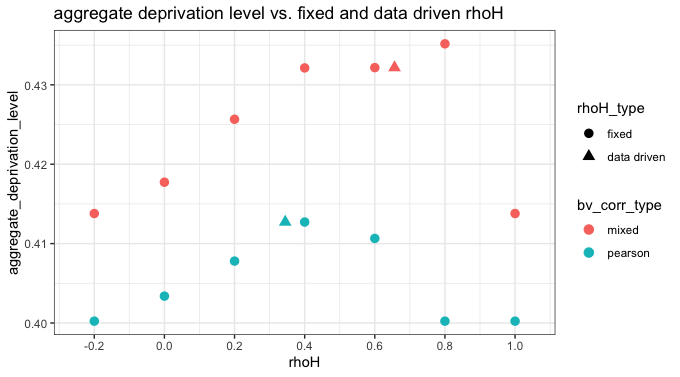
As far as this model with simulated data is representative of the
behavior of rhoH, it would appear that the maximum
aggregate deprivation level is at or near the one obtained when
rhoH is entirely data-driven.
Setting a fixed value for rhoH by the user is rarely
called for, except when a constant rhoH is required for the
comparison of several models with
double-weighting.
As a technicality, it may be noted that, if the user chooses more
than one dimension, rhoH is common for all. If this is the
case and rhoH is data-driven, rhoH might not
equal the correlation coefficient between any of the items pairs within
the dimensions. Instead the correlation coefficient at the upper bound
of the greatest gap may be between two items that belong to different
dimensions. This definition is necessary in order to avoid the breakdown
of the Betti-Verma formula in models in which some dimension(s) has/have
only one element. The technicality is of no practical consequence for
the user.
Flexible Double Weighting Schemes beyond Betti-Verma
Although historically Betti and Verma devised double-weighting for
the method named after them, mdepriv makes it available in
the other methods as well. That is, additionally to the standard methods the arguments
wa and wb provide alternative, more flexible
ways to select the weighting schemes. Weights are computed as the
product of two terms as in the Betti-Verma scheme. wa
selects the form of the first factor and is one of "cz",
"ds", "bv" or "equal".
wb selects the form of the second factor and is one of
"mixed", "pearson" or "diagonal",
where the latter sets all off-diagonal correlations to zero. Any true
double-weighting scheme involves rhoH as does the Betti-Verma
method, either as data-driven (the default) or fixed by
specification.
Thus applying "diagonal" to wb and
specifying wa as "cz", "ds" or
"equal" basically delivers the same result as when choosing
the corresponding named method. Only the first
output element differs:
ds <- mdepriv(simul_data, c("y1", "y2", "y3"), method = "ds")
ds[1]
#> $weighting_scheme
#> [1] "Desai & Shah (1988) weighting scheme"
ds_diagonal <- mdepriv(simul_data, c("y1", "y2", "y3"), wa = "ds", wb = "diagonal")
ds_diagonal[1]
#> $weighting_scheme
#> [1] "User-defined weighting scheme: wa = \"ds\", wb = \"diagonal\"."
all.equal(ds[-1], ds_diagonal[-1])
#> [1] TRUEBetti & Verma (1998) weighting schemes also have lookalikes among
the wa-wb-combinations:
bv <- mdepriv(simul_data, c("y1", "y2", "y3"), method = "bv", bv_corr_type = "pearson", rhoH = 0.3)
bv[1]
#> $weighting_scheme
#> [1] "Betti & Verma (1998) weighting scheme"
bv_pearson <- mdepriv(simul_data, c("y1", "y2", "y3"), wa = "bv", wb = "pearson", rhoH = 0.3)
bv_pearson[1]
#> $weighting_scheme
#> [1] "User-defined weighting scheme: wa = \"bv\", wb = \"pearson\"."
all.equal(bv[-1], bv_pearson[-1])
#> [1] TRUESo lets have a look at the items weights of some non-standard
wa-wb-weighting schemes:
items_sel <- c("y1", "y2", "y3", "y4", "y5", "y6", "y7") # a selection of items
# wa-wb-combinations
(wa_wb <- data.frame(
wa = c("cz", "ds", "equal", "bv"),
wb = c(rep("mixed", 3), "diagonal")
))
#> wa wb
#> 1 cz mixed
#> 2 ds mixed
#> 3 equal mixed
#> 4 bv diagonal
# list with summaries by items for each wa-wb-combination
summary_by_item <- lapply(
1:nrow(wa_wb),
function(x) mdepriv(simul_data, items_sel, wa = wa_wb$wa[x], wb = wa_wb$wb[x], output = "summary_by_item")
)
# channel figures to a plot
tibble(wa_wb, summary_by_item) %>% # gather varied arguments & outputs in a tibble / data.frame
mutate(
wa = fct_inorder(wa), # order arguments ...
wb = fct_inorder(wb) # ... by first appearance
) %>%
unnest() %>%
filter(Item != "Total") %>% # filter out rows with the totals inherited from the summary_by_item-tables
ggplot(aes(x = Item, y = Weight, fill = Item)) +
geom_col(position = position_dodge()) +
facet_wrap(vars(wa, wb), ncol = 2) +
theme_bw() +
ggtitle("Item Weights from User Defined Double Weighting Schemes")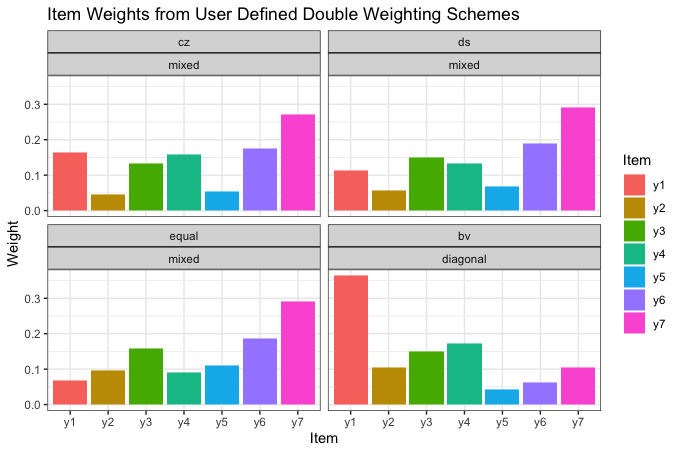
The largest differences in weights are between the
"bv"-"diagonal" model vs. the three others,
for all of which wb as set to "mixed". In the
former, the correlations among items have no effect on the weights
because of wb = "diagonal". In the latter,
they take full effect, due to wb = “mixed".
Note that for each of the seven items, the Desai-Shaw weight is in the
interval defined by the respective Cerioli-Zani and equi-proportionate
weights. This is so because Desai-Shaw’s sensitivity to the means of
items is less than that of Cerioli-Zani; it is higher than in the
equi-proportionate method, which is indifferent to the item means. The remarks and table above give reasons for
selecting particular wa-wb-combinations in reference to analytic
objectives.
Expertise-Based Weights for Items
Instead of a data-driven weighting scheme users can pass
expertise-based weights to items. This is done by structuring the
argument user_def_weights analogously to the
items’ argument. For each of the dimensions (= group of items)
the user-defined weights must sum up to 1. When returned as an output
user_def_weights inherits the dimensions’ labelling
specified by the items’ argument.
mdepriv(simul_data,
items = list("Group A" = c("y1", "y2"), "Group B" = c("y5", "y6")),
user_def_weights = list(c(0.65, 0.35), c(0.8, 0.2)),
output = c(
"weighting_scheme",
"summary_by_dimension",
"summary_by_item",
"items",
"user_def_weights"
)
)
#> $weighting_scheme
#> [1] "Item-wise user-defined weighting scheme"
#>
#> $summary_by_dimension
#> Dimension N_Item Index Weight Contri Share
#> 1 Group A 2 0.34900 0.5 0.17450 0.3470427
#> 2 Group B 2 0.65664 0.5 0.32832 0.6529573
#> 3 Total 4 NA 1.0 0.50282 1.0000000
#>
#> $summary_by_item
#> Dimension Item Index Weight Contri Share
#> 1 Group A y1 0.16000 0.325 0.052000 0.10341673
#> 2 Group A y2 0.70000 0.175 0.122500 0.24362595
#> 3 Group B y5 0.69579 0.400 0.278316 0.55351020
#> 4 Group B y6 0.50004 0.100 0.050004 0.09944712
#> 5 Total <NA> NA 1.000 0.502820 1.00000000
#>
#> $items
#> $items$`Group A`
#> [1] "y1" "y2"
#>
#> $items$`Group B`
#> [1] "y5" "y6"
#>
#>
#> $user_def_weights
#> $user_def_weights$`Group A`
#> [1] 0.65 0.35
#>
#> $user_def_weights$`Group B`
#> [1] 0.8 0.2Check the Weighting Scheme
The mdepriv arguments method,
bv_corr_type, wa, wb,
rhoH and/or user_def_weights set the weighting
scheme. method, bv_corr_type and
rhoH have default values. Any setting of
bv_corr_type is bypassed if method is not
"bv" and both wa and wb are
unspecified. Any rhoH setting is bypassed if an effective single weighting scheme is
applied. If user_def_weights is specified, the arguments
method, bv_corr_type, wa,
wb and rhoH do not matter. If that is
confusing, the output elements
"weighting_scheme", "wa", "wb",
"rhoH" and "user_def_weights" can always be
relied upon to tell the specifics of the weighting scheme effectively
applied.
What’s going on under the hood if …
… no method is specified?
mdepriv(simul_data, c("y1", "y2", "y3"),
output = c("weighting_scheme", "wa", "wb", "rhoH", "user_def_weights"))
#> $weighting_scheme
#> [1] "Cerioli & Zani (1990) weighting scheme"
#>
#> $wa
#> [1] "cz"
#>
#> $wb
#> [1] "diagonal"
#>
#> $rhoH
#> [1] NA
#>
#> $user_def_weights
#> [1] NA… bv as method and else nothing with
relevance for the weighing scheme is specified?
mdepriv(simul_data, c("y1", "y2", "y3"), method = "bv",
output = c("weighting_scheme", "wa", "wb", "rhoH", "user_def_weights"))
#> $weighting_scheme
#> [1] "Betti & Verma (1998) weighting scheme"
#>
#> $wa
#> [1] "bv"
#>
#> $wb
#> [1] "mixed"
#>
#> $rhoH
#> [1] 0.3472574
#>
#> $user_def_weights
#> [1] NA… bv as method + the associated
bv_corr_type and rhoH are specified?
mdepriv(simul_data, c("y1", "y2", "y3"), method = "bv", bv_corr_type = "pearson", rhoH = 0.3,
output = c("weighting_scheme", "wa", "wb", "rhoH", "user_def_weights"))
#> $weighting_scheme
#> [1] "Betti & Verma (1998) weighting scheme"
#>
#> $wa
#> [1] "bv"
#>
#> $wb
#> [1] "pearson"
#>
#> $rhoH
#> [1] 0.3
#>
#> $user_def_weights
#> [1] NA… an effective single weighting method + meaningless
bv_corr_type and rhoH are specified?
mdepriv(simul_data, c("y1", "y2", "y3"), method = "ds", bv_corr_type = "pearson", rhoH = 0.3,
output = c("weighting_scheme", "wa", "wb", "rhoH", "user_def_weights"))
#> $weighting_scheme
#> [1] "Desai & Shah (1988) weighting scheme"
#>
#> $wa
#> [1] "ds"
#>
#> $wb
#> [1] "diagonal"
#>
#> $rhoH
#> [1] NA
#>
#> $user_def_weights
#> [1] NA… user defined effective single weighting scheme and some meaningless
rhoH specification are applied?
mdepriv(simul_data, c("y1", "y2", "y3"), wa = "bv", wb = "diagonal", rhoH = 0.7,
output = c("weighting_scheme", "wa", "wb", "rhoH", "user_def_weights"))
#> $weighting_scheme
#> [1] "User-defined weighting scheme: wa = \"bv\", wb = \"diagonal\"."
#>
#> $wa
#> [1] "bv"
#>
#> $wb
#> [1] "diagonal"
#>
#> $rhoH
#> [1] NA
#>
#> $user_def_weights
#> [1] NA… user defined double weighting scheme with + rhoH
specification kick in?
mdepriv(simul_data, c("y1", "y2", "y3"), wa = "equal", wb = "mixed", rhoH = 0.5,
output = c("weighting_scheme", "wa", "wb", "rhoH", "user_def_weights"))
#> $weighting_scheme
#> [1] "User-defined weighting scheme: wa = \"equal\", wb = \"mixed\"."
#>
#> $wa
#> [1] "equal"
#>
#> $wb
#> [1] "mixed"
#>
#> $rhoH
#> [1] 0.5
#>
#> $user_def_weights
#> [1] NA… expertise-base weighting scheme and an ignored method
are applied?
mdepriv(simul_data, list(c("y1", "y2"), c("y3", "y4")), method = "cz",
user_def_weights = list(c(0.3, 0.7), c(0.45, 0.55)),
output = c("weighting_scheme", "wa", "wb", "rhoH", "user_def_weights"))
#> $weighting_scheme
#> [1] "Item-wise user-defined weighting scheme"
#>
#> $wa
#> [1] NA
#>
#> $wb
#> [1] NA
#>
#> $rhoH
#> [1] NA
#>
#> $user_def_weights
#> $user_def_weights$`Dimension 1`
#> [1] 0.3 0.7
#>
#> $user_def_weights$`Dimension 2`
#> [1] 0.45 0.55 As shown above the
output elements "weighting_scheme",
"wa", "wb", "rhoH" and
"user_def_weights" tell reliably the specifics of the
weighting scheme effectively applied. With the exception of
"weighting_scheme", those output elements can
be re-used as specifications for homonymous arguments in another
model.
model <- mdepriv(simul_data, c("y1", "y2", "y3"), output = "all")
model$wa
#> [1] "cz"
model$wb
#> [1] "diagonal"
other_model <- mdepriv(simul_data, c("y1", "y2", "y3"), wa = model$wa, wb = model$wb, output = "all")
all.equal(model, other_model) # is there a difference? ...
#> [1] "Component \"weighting_scheme\": 1 string mismatch"
# ... expect for weighting_scheme all outputs are the same
model$weighting_scheme
#> [1] "Cerioli & Zani (1990) weighting scheme"
other_model$weighting_scheme
#> [1] "User-defined weighting scheme: wa = \"cz\", wb = \"diagonal\".""wa" can be applied also to the argument
method of another model:
model <- mdepriv(simul_data, c("y1", "y2", "y3"), output = "all")
other_model <- mdepriv(simul_data, c("y1", "y2", "y3"), method = model$wa, output = "all")
all.equal(model, other_model) # no difference
#> [1] TRUEWhereas "wb" can be applied only to the argument
bv_corr_type, and only if it is not
"diagonal":
model <- mdepriv(simul_data, c("y1", "y2", "y3"), method = "bv", bv_corr_type = "pearson", output = "all")
other_model <- mdepriv(simul_data, c("y1", "y2", "y3"), method = model$wa, bv_corr_type = model$wb, output = "all")
all.equal(model, other_model) # no difference
#> [1] TRUENote that situations where recycling of outputs as
specifications for setting weighting schemes make sense are rare. This
is the case if a certain weighting scheme should be run on different
datasets or different selections of items. Except for data driven
rhoHs and specified user_def_weights, which
are cumbersome to re-type (with every digit) there is not much practical
use for doing so.
Obtaining the Scores
The scores are the individual deprivation values, calculated as the
vector products of the individual item values and the weights returned
by mdepriv.
The score summary is obtained via the output option
"summary_scores":
items_sel <- c("y1", "y2", "y3", "y4", "y5", "y6", "y7") # a selection of items
mdepriv(simul_data, items_sel, method = "ds", output = "summary_scores")
#> N_Obs. Mean Std._Dev. Min Max
#> 1 100 0.4135734 0.1982925 0.08118954 0.9443571The output option "score_i" provides direct
access to the vector of scores for their immediate further use:
items_sel <- c("y1", "y2", "y3", "y4", "y5", "y6", "y7") # a selection of items
bv_diagonal_scores <- mdepriv(simul_data, items_sel, "sampl_weights",
wa = "bv", wb = "diagonal", output = "score_i")
eq_mixed_scores <- mdepriv(simul_data, items_sel, "sampl_weights",
wa = "equal", wb = "mixed", output = "score_i")
par(mfrow = c(1, 3), mar = c(4, 4, 4, 1), oma = c(0.5, 0.5, 0.5, 0), las = 1)
hist(bv_diagonal_scores, ylim = c(0, 15), breaks = seq(0, 1, 0.05),
xlab = "", main = "scores: wa: bv & wb: diagonal", col = "gray")
hist(eq_mixed_scores, ylim = c(0, 15), breaks = seq(0, 1, 0.05),
xlab = "", main = "scores: wa = equal & wb = mixed", col = "gray")
plot(bv_diagonal_scores, eq_mixed_scores,
xlim = c(0, 1), ylim = c(0, 1),
xlab = "scores: wa: bv & wb: diagonal",
ylab = "scores: wa: equal & wb: mixed",
main = "scores: bv/diagonal vs. equal/mixed")
abline(0, 1, lty = 2, lwd = 2, col = "red")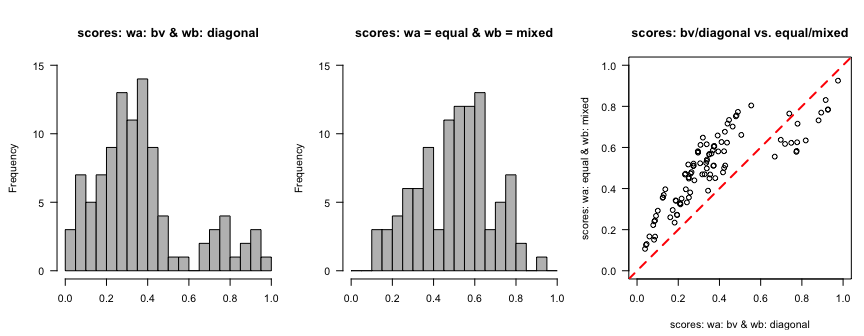
These scores are also merged to the output element
"data":
# default heading of score column
mdepriv(simul_data, items_sel, output = "data") %>% head(3)
#> id y1 y2 y3 y4 y5 y6 y7 sampl_weights score_i
#> 1 1 0 0 0 0.0 0.369 0.174 0.196 0.556 0.06663388
#> 2 2 1 0 1 0.2 0.762 0.832 1.000 1.500 0.72888025
#> 3 3 0 1 1 0.4 0.708 0.775 0.833 0.973 0.49115525
# user-defined heading of score column
mdepriv(simul_data, items_sel, score_i_heading = "score_i_user_name", output = "data") %>% head(3)
#> id y1 y2 y3 y4 y5 y6 y7 sampl_weights score_i_user_name
#> 1 1 0 0 0 0.0 0.369 0.174 0.196 0.556 0.06663388
#> 2 2 1 0 1 0.2 0.762 0.832 1.000 1.500 0.72888025
#> 3 3 0 1 1 0.4 0.708 0.775 0.833 0.973 0.49115525Thus the scores are accessible in two ways:
items_sel <- c("y1", "y2", "y3", "y4", "y5", "y6", "y7") # a selection of items
model <- mdepriv(simul_data, items_sel, output = "all") # method (default) = "cz"
all.equal(model$score_i, model$data$score_i)
#> [1] TRUEThe score column heading impacts the ability of the
output element "data" being used as input
data in another model:
new_model <- mdepriv(model$data, items_sel, method = "ds", output = "all")
#> Error: "score_i" is not valid as argument 'score_i_heading' for the current model. For the argument 'data' already includes a column by this name, possibly as the result of a previous mdepriv model. Therefore, give a different name for the scores column in the output data by specifying the argument 'score_i_heading'.Note: "score_i" is the default setting of the argument
score_i_heading. By distinguishing the score columns using
the argument score_i_heading in a cascade of models, the
output element "data" can be re-used multiple
times.
new_model <- mdepriv(model$data, items_sel, method = "ds", score_i_heading = "new_score_i", output = "all")
head(new_model$data, 3) %>% mutate_if(is.double, function(x) round(x, 3))
#> id y1 y2 y3 y4 y5 y6 y7 sampl_weights score_i new_score_i
#> 1 1 0 0 0 0.0 0.369 0.174 0.196 0.556 0.067 0.082
#> 2 2 1 0 1 0.2 0.762 0.832 1.000 1.500 0.729 0.715
#> 3 3 0 1 1 0.4 0.708 0.775 0.833 0.973 0.491 0.571If the purpose is to gather the scores columns from a cascade of models, and in order to avoid confusion, it is expedient to name each scores column with reference to its very model:
model_1 <- mdepriv(simul_data, items_sel, method = "bv",
score_i_heading = "score_i_1", output = "all")
model_2 <- mdepriv(model_1$data, items_sel, method = "ds",
score_i_heading = "score_i_2", output = "all")
model_3 <- mdepriv(model_2$data, items_sel, wa = "cz", wb = "mixed",
score_i_heading = "score_i_3", output = "all")
head(model_3$data, 3) %>% mutate_if(is.double, function(x) round(x, 3))
#> id y1 y2 y3 y4 y5 y6 y7 sampl_weights score_i_1 score_i_2 score_i_3
#> 1 1 0 0 0 0.0 0.369 0.174 0.196 0.556 0.082 0.082 0.103
#> 2 2 1 0 1 0.2 0.762 0.832 1.000 1.500 0.788 0.715 0.786
#> 3 3 0 1 1 0.4 0.708 0.775 0.833 0.973 0.644 0.571 0.641Two-Level Deprivation Model
To demonstrate a two-level deprivation model with the Betti-Verma
double weighting rule operating at both levels we use the dataset
MSNA_HC.
help("MSNA_HC")Check the dataset structure…
str(MSNA_HC)
#> 'data.frame': 2855 obs. of 15 variables:
#> $ id : int 1 2 3 4 5 6 7 8 9 10 ...
#> $ sampl_weights : num 0.636 1.086 0.657 0.657 1.086 ...
#> $ upazilla : chr "Teknaf" "Teknaf" "Teknaf" "Teknaf" ...
#> $ union : chr "Teknaf Paurashava" "Nhilla" "Baharchara" "Baharchara" ...
#> $ hhh_gender : chr "male" "male" "male" "male" ...
#> $ ls_1_food : num 0.518 0.728 0.362 0.554 0.464 ...
#> $ ls_2_livelihood: num 0.5 0.5 0.5 0.5 0.75 1 0.75 0.75 0.5 1 ...
#> $ ls_3_shelter : num 0.9137 0.3204 0.3204 0.0696 0.3204 ...
#> $ water_1 : int 0 0 0 0 0 0 0 0 0 1 ...
#> $ water_2 : int 0 0 0 0 1 0 0 1 0 1 ...
#> $ water_3 : int 0 0 0 0 0 0 0 0 0 0 ...
#> $ sanit_1 : int 1 1 0 1 1 1 1 1 0 1 ...
#> $ sanit_2 : int 0 0 0 0 0 0 0 1 1 1 ...
#> $ sanit_3 : int 1 1 0 0 0 1 0 1 0 0 ...
#> $ sanit_4 : int 0 0 0 1 0 0 0 1 0 0 ...… and the distribution of every item:
items <- MSNA_HC %>% select(ls_1_food:sanit_4) %>% names() # all items
MSNA_HC %>%
pivot_longer(cols = all_of(items), names_to = "item", values_to = "value") %>%
ggplot(aes(value)) +
geom_histogram(breaks = seq(0, 1, 0.05)) +
facet_wrap(~item, ncol = 3) +
theme_bw() +
ggtitle("Item Distributions")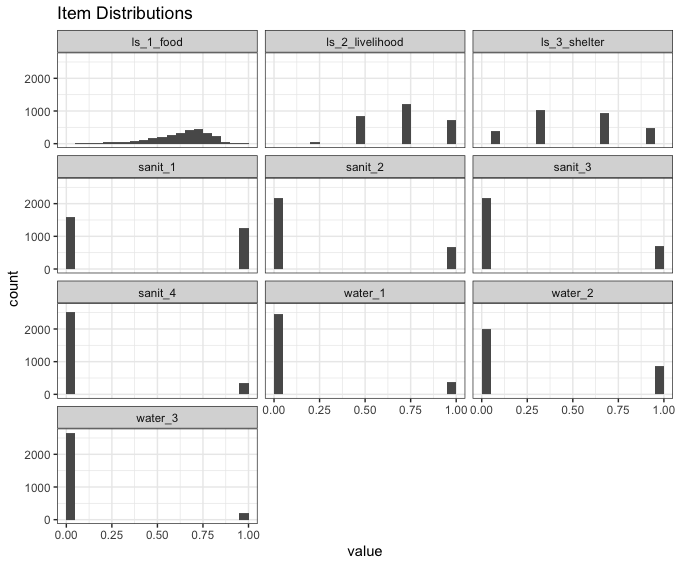
At the lower level (level_1), the seven binary WASH
(Water, Sanitation and Hygiene) items will be aggregated to a continuous
WASH deprivation indicator, ls_4_WASH. To equalize
subsector contributions, water (prefix water_) and
sanitation (prefix sanit_) items are grouped in different
dimensions.
# grouping items in dimensions
items_level_1 <- list("water" = str_subset(items, "^water_"), "sanit" = str_subset(items, "^sanit_"))Check correlation type of items pairs according to the mixed-rule
corr_mat(MSNA_HC, items_level_1, output = "type") # corr_type (default) = "mixed"
#> $water
#> water_1 water_2 water_3
#> water_1 "polychoric" "polychoric" "polychoric"
#> water_2 "polychoric" "polychoric" "polychoric"
#> water_3 "polychoric" "polychoric" "polychoric"
#>
#> $sanit
#> sanit_1 sanit_2 sanit_3 sanit_4
#> sanit_1 "polychoric" "polychoric" "polychoric" "polychoric"
#> sanit_2 "polychoric" "polychoric" "polychoric" "polychoric"
#> sanit_3 "polychoric" "polychoric" "polychoric" "polychoric"
#> sanit_4 "polychoric" "polychoric" "polychoric" "polychoric"
# all correlations are of type "polychoric"In this humanitarian context, there is no basis to consider one or
the other water or sanitation problem more or less important on the
basis of their different prevalence. Therefore, in aggregating the seven
binary water and sanitation items, for the first weighting factor we set
the argument wa = "equal". However, we keep
redundancy control active. That is, the second weighting factor
wb = "mixed" has the effect of reducing
weights on more redundant items. (Note that because all WASH items are binary 0 or 1,
choosing "mixed" results in
"polychoric" for all item pairs. wb =
"diagonal" would be neutral to redundancy; and
wb = "pearson" would underrate the strength of
correlations between binary items).
This model returns the deprivation scores as a column
"ls_4_WASH" (argument score_i_heading) merged
to the output element "data":
model_level_1 <- mdepriv(MSNA_HC, items_level_1, "sampl_weights", wa = "equal", wb = "mixed",
score_i_heading = "ls_4_WASH", output = "all")
# check structure of output element data
model_level_1$data %>% str()
#> 'data.frame': 2855 obs. of 16 variables:
#> $ id : int 1 2 3 4 5 6 7 8 9 10 ...
#> $ sampl_weights : num 0.636 1.086 0.657 0.657 1.086 ...
#> $ upazilla : chr "Teknaf" "Teknaf" "Teknaf" "Teknaf" ...
#> $ union : chr "Teknaf Paurashava" "Nhilla" "Baharchara" "Baharchara" ...
#> $ hhh_gender : chr "male" "male" "male" "male" ...
#> $ ls_1_food : num 0.518 0.728 0.362 0.554 0.464 ...
#> $ ls_2_livelihood: num 0.5 0.5 0.5 0.5 0.75 1 0.75 0.75 0.5 1 ...
#> $ ls_3_shelter : num 0.9137 0.3204 0.3204 0.0696 0.3204 ...
#> $ water_1 : int 0 0 0 0 0 0 0 0 0 1 ...
#> $ water_2 : int 0 0 0 0 1 0 0 1 0 1 ...
#> $ water_3 : int 0 0 0 0 0 0 0 0 0 0 ...
#> $ sanit_1 : int 1 1 0 1 1 1 1 1 0 1 ...
#> $ sanit_2 : int 0 0 0 0 0 0 0 1 1 1 ...
#> $ sanit_3 : int 1 1 0 0 0 1 0 1 0 0 ...
#> $ sanit_4 : int 0 0 0 1 0 0 0 1 0 0 ...
#> $ ls_4_WASH : num 0.237 0.237 0 0.267 0.282 ...At the second level (level_2), in the aggregation of the
four continuous living-standards-indicators (ls_1_food,
ls_2_livelihood, ls_3_shelter,
ls_4_WASH), the default Betti-Verma method is used, by
setting method = "bv". This activates both
mechanisms of the double-weighting scheme - rewarding more
discriminating indicators with higher weights, and penalizing redundant
ones with lower weights.
# save the "data" returned by the lower level model
MSNA_HC_2 <- model_level_1$data
# save all column headings with prefix ls_ (living standards) as items of the higher level
(items_level_2 <- names(MSNA_HC_2) %>% str_subset("^ls_"))
#> [1] "ls_1_food" "ls_2_livelihood" "ls_3_shelter" "ls_4_WASH"
# save higher level model
model_level_2 <- mdepriv(MSNA_HC_2, items_level_2, method = "bv", output = "all")Compare the items and scores of the second level:
model_level_2$data %>%
pivot_longer(cols = all_of(items_level_2), names_to = "item", values_to = "value") %>%
ggplot(aes(x = value, y = score_i, col = hhh_gender)) +
geom_point(pch = 1, alpha = 0.5) +
facet_wrap(~item, ncol = 2) +
scale_x_continuous(breaks = seq(0, 1, 0.2), limits = c(0, 1)) +
scale_y_continuous(breaks = seq(0, 1, 0.2), limits = c(0, 1)) +
theme_bw() +
ggtitle("ls model (2nd level): items vs. score_i") +
labs(col = "gender of\nhousehold\nhead")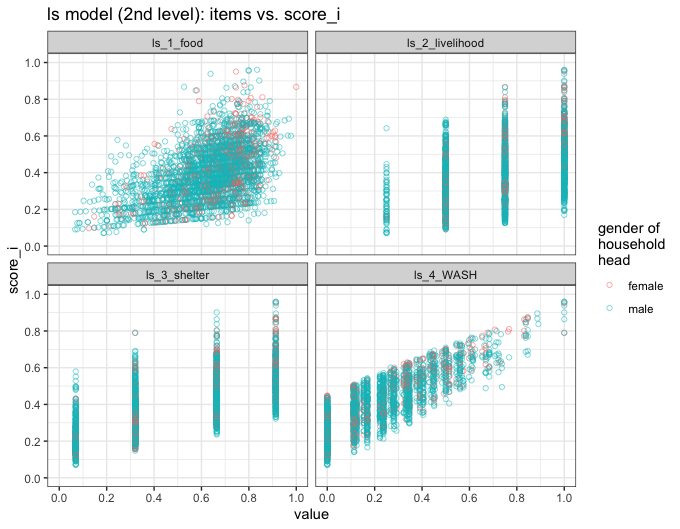
Since the scores are returned merged to the original data it is easy to compare them to variables with potential explanatory value. Thus, we ask: Do union (commune) and gender of household head have any predictive value for the distribution of deprivation scores?
model_level_2$data %>%
ggplot(aes(x = union, y = score_i, fill = hhh_gender)) +
stat_boxplot(geom = "errorbar", width = 0.5, position = position_dodge(0.7)) +
geom_boxplot(width = 0.6, position = position_dodge(0.7)) +
theme_bw() +
scale_y_continuous(breaks = seq(0, 1, 0.2), limits = c(0, 1)) +
ggtitle("union (commune), gender of household head vs. score_i") +
labs(fill = "gender of\nhousehold\nhead", x = "union (commune)") +
theme(axis.text.x = element_text(angle = 45, hjust = 1)) +
annotate("text",
x = 1, y = 1, hjust = 0,
label = paste0("female: n = ", sum(model_level_2$data$hhh_gender == "female"))
) +
annotate("text",
x = 1, y = 0.95, hjust = 0,
label = paste0("male: n = ", sum(model_level_2$data$hhh_gender == "male"))
)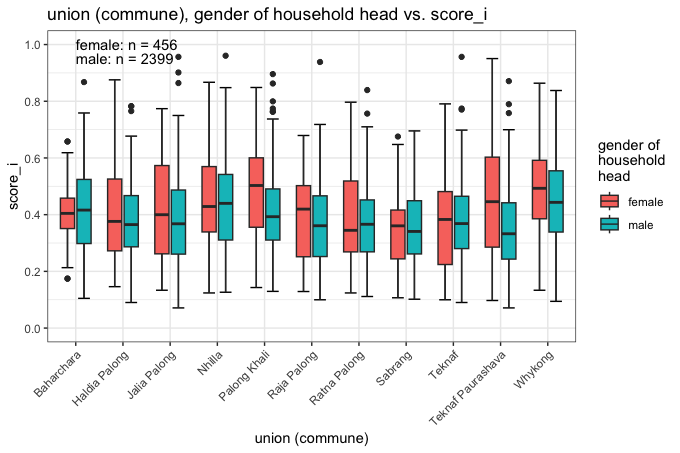
Of particular note are the gender differences (much higher median deprivation scores for female-headed households) in Palong Khali Union and in the Teknaf Upazila headquarter Union (Paurashava).
Handling Missing Values
mdepriv() does not allow any missing values among
variables specified by the arguments items or
sampling_weights. In other words, mdepriv()
does not automatically under the hood filter out such observations from
the input data.
Although inconvenient, the absence of such tacit filtering is for a
good reason. In multi-level models that use different variables as
items at each level, there is the potential of sequentially
decreasing numbers of complete observations. The user, aware of this
risk, should filter out observations with missing values in any of the
variables entered in the whole model. This step should be taken prior to
running the model at the first level.
To demonstrate the handling of missing values, we use the same specification of arguments as in the above two-level-deprivation model, but a dataset containing missing values among items selected for the 1st and 2nd level as well as among the sampling weights.
We recall the items and sampling weight specification:
items_level_1
#> $water
#> [1] "water_1" "water_2" "water_3"
#>
#> $sanit
#> [1] "sanit_1" "sanit_2" "sanit_3" "sanit_4"
items_level_2
#> [1] "ls_1_food" "ls_2_livelihood" "ls_3_shelter" "ls_4_WASH"
# As noted earlier, the 4th item holds the scores from the model's 1st level
"sampl_weights"
#> [1] "sampl_weights"We gather the names of the variables (arguments items
and sampling_weights) which require complete values in
order for mdepriv() to execute the model:
vars_required_complete <- c(
items_level_1 %>% unlist() %>% unname(),
items_level_2[-4], # without "ls_4_WASH"
"sampl_weights"
)For the purpose of demonstration some of the values of those
variables are replaced with NA (= missing values):
MSNA_HC_with_NA <- MSNA_HC
for (i in seq_along(vars_required_complete)) {
MSNA_HC_with_NA[i * 10 + (-9:25), vars_required_complete[i]] <- NA
}Now we try to run the first-level model. mdepriv()
responds with this error message:
model_level_1 <- mdepriv(MSNA_HC_with_NA, items_level_1, "sampl_weights",
wa = "equal", wb = "mixed",
score_i_heading = "ls_4_WASH", output = "all")
#> Error: The argument 'items' contains the following variables with NA: "water_1", "water_2", "water_3", "sanit_1", "sanit_2", "sanit_3" and "sanit_4". The argument 'items' does not allow any NA-values.One might be tempted to filter out only those records from the input
dataset (argument data) with NAs in the
variables that the error message pointed out. However, that would not be
enough; the error message addresses only the use of items in the model’s
1st level. The items of the 2nd level and the
sampling weights, too need to be inspected for NAs:
MSNA_HC_with_NA %>%
# select(all_of(vars_required_complete)) %>%
# uncomment above line if only variables required to be complete should be visualized
vis_dat(sort_type = FALSE)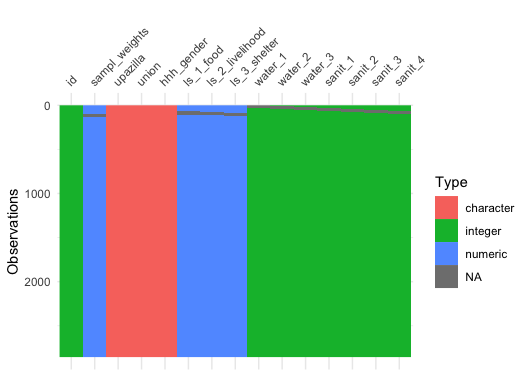
The above graphic reveals missing values also
in the 2nd-level items (ls_1_food,
ls_2_livelihood, ls_3_shelter) as well as in
the sampling weights.
Hint: If there are only relatively few missing values /
NAs, the function visdat::vis_dat() may not be
the best option to visualize them. Instead you could try out
visdat::vis_miss(). This function tags the percentage of
missing values in each variable to its label and the percentages of
incomplete observations across all selected variables to the legend. (s. below).
If we intend to link the scores obtained with mdepriv()
back to each observation within the original dataset containing
NAs among the specified items and/or
sampling_weights a variable column with a unique value for
each row as a valid identifier for each record is required. Thus we
check if id is a valid identifier:
n_distinct(MSNA_HC_with_NA$id, na.rm = TRUE) == nrow(MSNA_HC_with_NA)
#> [1] TRUEIf that is not the case, a new valid identifier column must be added to the dataset:
# MSNA_HC_with_NA$id_new <- 1:nrow(MSNA_HC_with_NA)Now we filter for records with complete values among the items and sampling weights:
MSNA_HC_filtered <- MSNA_HC_with_NA %>% filter(complete.cases(.[vars_required_complete]))After filtering, the model (here one with two levels) works as usual:
# save lower level model
model_level_1 <- mdepriv(MSNA_HC_filtered, items_level_1, "sampl_weights",
wa = "equal", wb = "mixed",
score_i_heading = "ls_4_WASH", output = "all")
# save the "data" returned by the lower level model
MSNA_HC_filtered_2 <- model_level_1$data
# save higher level model
model_level_2 <- mdepriv(MSNA_HC_filtered_2, items_level_2, method = "bv", output = "all")Now we can merge back:
data_4_join <- model_level_2$data %>%
select(id, setdiff(names(.), names(MSNA_HC_with_NA)))
head(data_4_join, 3)
#> id ls_4_WASH score_i
#> 1 136 0.3456620 0.5476448
#> 2 137 0.2323856 0.3854030
#> 3 138 0.2221500 0.3557398
MSNA_HC_with_NA <- left_join(MSNA_HC_with_NA, data_4_join, by = "id")Our demonstration is done and we check the outcome with
visdat::vis_dat(). The missing values in the calculated
score variables ls_4_WASH (1st level) and
score_i (2nd level) correspond to observations
containing at least one missing value among the applied
items and sampling_weights:
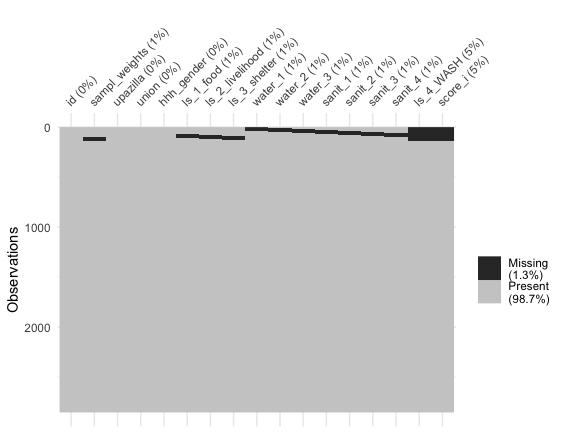
nrow(MSNA_HC_with_NA) # number of observations in original dataset
#> [1] 2855
model_level_2$summary_scores # scores summary of higher / 2nd level
#> N_Obs. Mean Std._Dev. Min Max
#> 1 2720 0.3955291 0.1512961 0.07108284 0.9606823
# percentage of observations with valid input and calculated scores
round(model_level_2$summary_scores$N_Obs. / nrow(MSNA_HC_with_NA) * 100, 2)
#> [1] 95.27The 95.27% are the complement to the 4.73% missing scores as shown in the above plot.
Multiple Models in a data.frame
The handling of returns of multiple mdepriv models,
which each comes as a list, can become cumbersome. We make
this more convenient by combining the lists in a
data.frame. Every model becomes a row and the different
output elements are gathered as columns/variables.
Saving some models’ outputs as lists:
outputs <- c("all", "summary_by_dimension")
# explicitly add the "summary_by_dimension" table so it's included also if no dimensions are specified
items_sel <- c("y1", "y2", "y3", "y4", "y5", "y6", "y7") # a selection of items
dim <- list(c("y1", "y2"), c("y3", "y4"), c("y5", "y6", "y7"))
# a grouping of items in dimensions
w_expertise <- list(c(0.4, 0.6), c(0.7, 0.3), c(0.45, 0.3, 0.25))
# expertise-base weights for (grouped) items
# models with no dimensions specified
bv <- mdepriv(simul_data, items_sel, method = "bv", output = outputs)
equal <- mdepriv(simul_data, items_sel, method = "equal", output = outputs)
bv_diagonal <- mdepriv(simul_data, items_sel, wa = "bv", wb = "diagonal", output = outputs)
equal_mixed <- mdepriv(simul_data, items_sel, wa = "equal", wb = "mixed", output = outputs)
# models with dimension specification
bv_dim <- mdepriv(simul_data, dim, method = "bv", output = outputs)
expertise_dim <- mdepriv(simul_data, dim, user_def_weights = w_expertise, output = outputs)Combining the lists to a data.frame:
l <- list(bv, equal, bv_diagonal, equal_mixed, bv_dim, expertise_dim)
# gather all the models' returns in one list
names(l) <- c("bv", "equal", "bv_diagonal", "equal_mixed", "bv_dim", "expertise_dim")
# name the list with reference to the models
mat <- do.call(rbind, l)
# turn each model-output / list-element into a row of a matrix
is(mat)
#> [1] "matrix" "array" "structure" "vector"
df <- as_tibble(mat) # turn the matrix into a data.frame/tibble
df$model <- fct_inorder(names(l))
# add a column for model names as factor ordered by first appearance
is(df)
#> [1] "tbl_df" "tbl" "data.frame" "list" "oldClass"
#> [6] "vector"For more insight into this data.frame use this code:
data.frame(
class_of_variable = map_chr(df, ~ class(.x)),
classes_within_variable = sapply(
names(df),
function(x)
map_chr(df[[x]], ~ class(.x)) %>%
unique() %>%
paste(collapse = " or ")
)
)
#> class_of_variable classes_within_variable
#> weighting_scheme list character
#> aggregate_deprivation_level list numeric
#> summary_by_dimension list data.frame
#> summary_by_item list data.frame
#> summary_scores list data.frame
#> score_i list numeric
#> sum_sampling_weights list numeric
#> data list data.frame
#> items list list
#> sampling_weights list character
#> wa list character
#> wb list character
#> rhoH list numeric
#> user_def_weights list logical or list
#> score_i_heading list character
#> model factor factorExcept for "model", all variables are of the class
list. As expected, only the
columns/outputs "user_def_weights" and
"user_def_weights" are at their core lists,
respectively lists or single logical NAs. The rest consists
either of single values, of vectors or of data.frames,
which are easy to compile to an overall data.frames with
dplyr::bind_rows() and tidyr::unnest().
Select and use model returns of interest saved in the
data.frame:
# compile a single column/variable consisting at its core of data.frames
bind_rows(df$summary_scores)
#> N_Obs. Mean Std._Dev. Min Max
#> 1 100 0.4321696 0.2013452 0.04912143 0.9603282
#> 2 100 0.4801443 0.1905186 0.10528571 0.9421429
#> 3 100 0.3717380 0.2273104 0.03950519 0.9744880
#> 4 100 0.5019077 0.1798727 0.10929403 0.9239400
#> 5 100 0.4049227 0.2040694 0.06620614 0.9555567
#> 6 100 0.5085708 0.2159222 0.08426667 0.9595000
# compile several variables to a data.frame ...
df %>% select("model", "wa", "wb", "rhoH", "summary_scores") %>% unnest()
#> # A tibble: 6 × 9
#> model wa wb rhoH N_Obs. Mean Std._Dev. Min Max
#> <fct> <chr> <chr> <dbl> <int> <dbl> <dbl> <dbl> <dbl>
#> 1 bv bv mixed 0.656 100 0.432 0.201 0.0491 0.960
#> 2 equal equal diagonal NA 100 0.480 0.191 0.105 0.942
#> 3 bv_diagonal bv diagonal NA 100 0.372 0.227 0.0395 0.974
#> 4 equal_mixed equal mixed 0.656 100 0.502 0.180 0.109 0.924
#> 5 bv_dim bv mixed 0.656 100 0.405 0.204 0.0662 0.956
#> 6 expertise_dim NA NA NA 100 0.509 0.216 0.0843 0.960
# compile and plot
par(cex = 0.65) # reduce plotting text
df %>%
select("model", "aggregate_deprivation_level") %>%
unnest() %>%
barplot(aggregate_deprivation_level ~ model, data = .)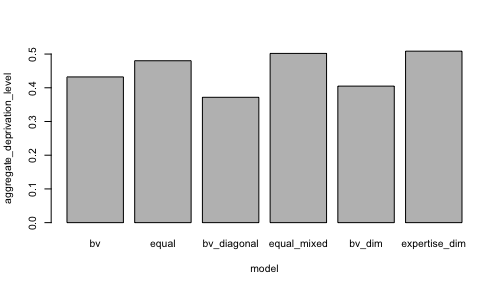
# and once again compile and plot
df %>%
select(c("model", "score_i")) %>%
unnest() %>%
ggplot(aes(score_i)) +
geom_histogram(breaks = seq(0, 1, 0.05)) +
facet_wrap(~model, ncol = 3) +
theme_bw() +
ggtitle("Distributions of deprivation scores, by model")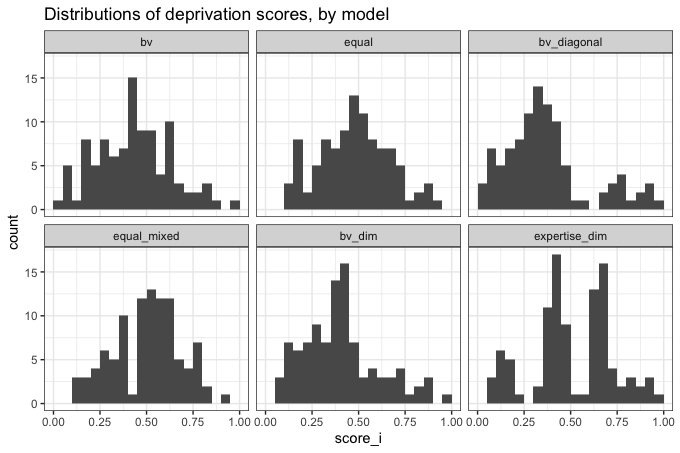
Acknowledgement
We thank Philippe Van Kerm, who, together with Maria Noel Pi Alperin, both with the Luxembourg Institute of Socio-Economic Research (LISER, formerly CEPS/INSTEAD, Luxembourg), wrote the code and documentation of the Stata command -mdepriv-, for encouraging us to translate it to R. We thank Patrice Chataigner, OkularAnalytics, Geneva, for moral and financial support. We thank Edouard Legoupil, UNHCR, for moral and technical support.
References
Betti, G. & Verma, V. K. (1998), ‘Measuring the degree of poverty in a dynamic and comparative context: a multi-dimensional approach using fuzzy set theory’, Working Paper 22, Dipartimento di Metodi Quantitativi, Universita di Siena. [A similar version is available at https://www.researchgate.net/profile/Gianni_Betti/publication/241227568_Measuring_the_degree_of_poverty_in_a_dynamic_and_comparative_context_A_multi-dimensional_approach_using_fuzzy_set_theory/links/00b49533307370c675000000/Measuring-the-degree-of-poverty-in-a-dynamic-and-comparative-context-A-multi-dimensional-approach-using-fuzzy-set-theory.pdf (2019-12-05)]
Cerioli, A. and S. Zani (1990). A fuzzy approach to the measurement of poverty. Income and wealth distribution, inequality and poverty. C. Dagum and M. Zenga. Urdorf, Switzerland, Springer: 272-284.
Desai, M. & Shah, A. (1988), ‘An econometric approach to the measurement of poverty’, Oxford Economic Papers, 40(3):505-522.
Lemmi, A. A. and G. Betti, Eds. (2006). Fuzzy set approach to multidimensional poverty measurement, Springer Science & Business Media.
Pi Alperin, M. N. & Van Kerm, P. (2009), ‘mdepriv - Synthetic indicators of multiple deprivation’, v2.0 (revised March 2014), CEPS/INSTEAD, Esch/Alzette, Luxembourg. http://medim.ceps.lu/stata/mdepriv_v3.pdf (2020-01-02).
